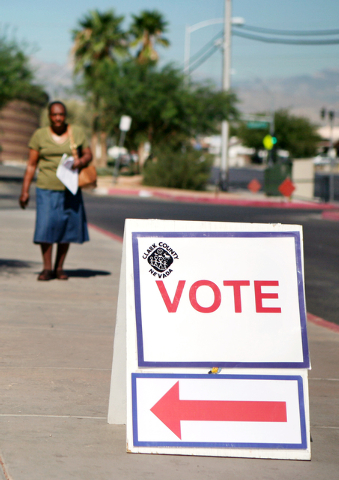Nevada’s political second banana gets top-line attention this year
The runaway favorite for re-election, Republican Gov. Brian Sandoval, is at the top of the June 10 primary ticket, but most of the attention this year has been on the more competitive GOP contest for lieutenant governor.
State Sen. Mark Hutchison, R-Las Vegas, whom Sandoval backs, and Sue Lowden are locked in a heated battle to win the GOP nomination for lieutenant governor. Lowden was endorsed by the Nevada Republican Party, once chaired by the former state senator, in a process Sandoval, Hutchison and other major Republicans boycotted. They disagreed with the party picking favorites before primary voters, even though GOP delegates in the end also endorsed Sandoval.
A third Republican, Chris Dyer, is in the lieutenant governor’s race, too, but hasn’t been in any of the five debates between Lowden and Hutchison, including two lively events televised statewide.
On the Democratic side, Assemblywoman Lucy Flores, D-Las Vegas, has given no attention to her little-known primary opponent, Harley Zane Kulkin. Instead, she’s preparing for the Nov. 4 general election.
The race for the state’s No. 2 job — which has few official duties beyond sitting on economic development and transportation boards and acting as president of the Nevada Senate with a tie-breaking vote — has high stakes this year because the lieutenant governor would take over if Sandoval doesn’t finish his full four-year term.
Although Sandoval insists he loves his job and has no plans to quit, he could run against U.S. Sen. Harry Reid-D-Nev., in 2016 or accept another federal judgeship or a Cabinet post if the GOP wins the White House.
Sandoval has four GOP opponents, but none are strong enough to give the governor any trouble in the primary. He faces a Democrat and a member of the Independent American Party in the Nov. 4 general election, but he’s expected to sail past them, too. Nevada’s first Hispanic governor is highly popular, enjoying job approval ratings of 60 percent or more.
With no U.S. Senate race, presidential election or hot governor’s contest to lure voters to the polls, the primary is expected to have a low turnout. Voters also tend to stay home during midterm elections when less is at stake.
Older Republican voters tend to turn out for all elections, so Democrats are urging their base to show up to make a difference, even though it will matter most for the general election.
“Your vote is not enough,” Nevada Democratic Party Chairwoman Roberta Lange told delegates at the Clark County Democratic Party Convention on May 3. Democrats should each “register one more voter,” walk for candidates and knock on doors to get voters out, she added.
Statewide, Democrats had a voter registration advantage over Republicans of about 64,000 at the end of April.
Nevada Republican Party Chairman Michael McDonald, speaking to the state party’s convention April 12, said members of the GOP must set aside any differences they have to elect strong Republicans. The GOP has been torn by rivalries among factions, including the conservative Tea Party movement and establishment Republicans.
At the local level, McDonald said Republicans have a chance to retake the state Senate from Democrats, who control the body by an 11-to-10 margin. Nationally, the GOP hopes to take the U.S. Senate, and Republicans already are laying the groundwork for the 2016 presidential election.
“If we don’t come together and heal now, we won’t take back the Senate, we won’t take back the White House,” McDonald said.
Secretary of State Ross Miller estimated turnout for the June 10 primary would be 15 to 20 percent. Turnout in the past four primaries has ranged from lows of 18 percent in 2008 and 19 percent in 2012 to a high of 30 percent in both 2006 and 2010, when competitive gubernatorial and U.S. Senate contests drove interest.
In Nevada’s four congressional races, Republican U.S. Reps. Joe Heck and Mark Amodei, R-Nev., face no GOP primary opposition, while Democratic U.S. Reps. Dina Titus and Steven Horsford face little-known primary opponents.
In the 1st Congressional District, Titus faces Democrat Herbert Glenn Peters, a former Libertarian who has lost more than a half-dozen congressional races in California and Nevada. Two Hispanic Republicans, Annette Teijeiro and José Padilla, are vying for the GOP nod to oppose Titus in the urban Las Vegas district that’s 2-to-1 Democratic by registration.
In the 2nd Congressional District, covering Northern Nevada, four Democrats are vying for the chance to take on Amodei, the general election favorite since he represents a mostly rural territory that’s heavily Republican.
In the 3rd Congressional District, Erin Bilbray, who is backed by the Democratic Party and Reid, faces little known contender Zachary Campbell. Bilbray is expected to face Heck in the most competitive general election race for Congress in a Southern Nevada district that’s nearly evenly split by party registration.
In the 4th Congressional District, Horsford faces two little-known Democrats, Sid Zeller and Mark Budetich. The GOP primary features a competitive race between Assemblyman Cresent Hardy, R-Mesquite, and Niger Innis, a conservative civil rights advocate who moved to Nevada in 2007. Two other Republicans also are in the race, Mike Monroe and Carlo Poliak.
In the Nevada Legislature, the focus is on the state Senate, where Republicans are pushing to retake control. The GOP would have to win three of the most competitive seats to take control: Districts 8, 9 and 20, which is held by Minority Leader Michael Roberson of Las Vegas.
There are no primary contests for three state offices: attorney general, secretary of state and treasurer.
Contact Laura Myers at lmyers@reviewjournal.com or 702-387-2919. Find her on Twitter: @lmyerslvrj.

Voter Election Guide
The go-to source for information and insight about the political candidates.


















